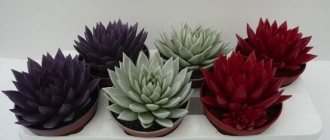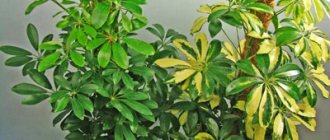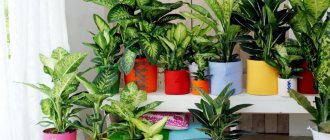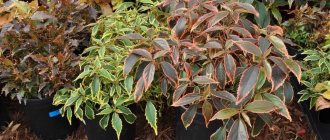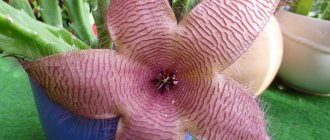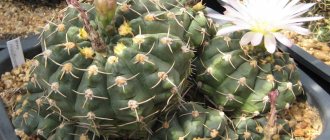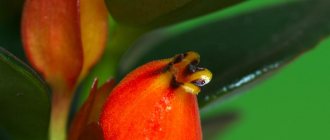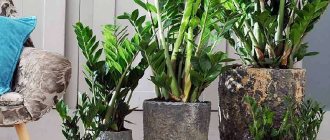The main difference from other amaryllis is the continuation of growth in winter. The white-flowered species and hybrids derived from it are most often grown in greenhouses and indoors. Most hemanthuses are modest in appearance, not fussy when caring for them at home, and are suitable for beginning gardeners.
Botanical description
Hemanthuses are perennial bulbous plants, have a decorative appearance, and are divided into evergreen and deciduous. The bulbs have an egg or pear shape, and the part located above the ground has a green tint. The roots are long and thick.
There are no more than six juicy, fleshy, thick leaves, belt-shaped. They grow from bulbs or on short cuttings . Smooth, shiny plates, drooping or erect, colors from pale gray to dark green. There are species with pubescent foliage, wavy edges, and yellowish spots.
Peduncles are strong, powerful, and may appear before the foliage has grown. The flowers are small, grouped in spherical umbrella-shaped inflorescences, the colors of the petals are white, pink, red.
The stamen is unusually long. The inflorescences are surrounded by bracts, the colors are the same as the petals.
During flowering, hemanthuses emit an unpleasant but weak aroma.
These plants are self-pollinating . The ball-shaped fruits look like fleshy berries. Colors pink, orange, red. Black achenes are small and lose their viability very quickly.
Varieties and photos
Hybrid varieties are grown indoors (on window sills, in flower pots, in floor vases), which differ from each other in the appearance of the foliage and the color of the petals. Below are photos, names and descriptions of hemanthus varieties suitable for propagation and care at home:
White-flowered
Most hybrids are bred from this species.
The glossy leaves are fleshy, smooth, dark, with fine pubescence along the edges of the plates. Peduncles are long (up to 25 cm), thick. Fluffy white flowers bloom in autumn and continue to bloom in winter.
Hybrids bred from white-flowered hemanthus:
- Prince Albert - the inflorescences are large, the petals have an orange tint;
- Hemanthus is pure white - the foliage is fluffy below, red bracts with pubescence, white flowers, yellow stamens, flowering begins in spring and lasts 3 months.
In the photo below is the Hemanthus White-flowered variety:
Garnet
This variety is also bred from the white-flowered species. The bulb is round, fleshy, the wavy foliage is long (up to 30 cm). The flower stalks grow up to 40 cm, the bracts are green (sometimes burgundy), and the petals have a red or ruby hue. Flowers bloom in summer, flowering ends in autumn.
Sharlakovy
This plant has an unusual appearance. The length of the bright green leaves reaches half a meter. The peduncle is powerful, speckled. Flowers with yellow stamens, red petals and bracts. Blooms in September, but not every year. The flowering period is short. This variety is the most capricious to care for . You can see what the Hemanthus Sharlakhovy variety looks like in the photo below:
brindle
This hybrid was given its name because of its spotting. There are brown spots on the leaf blades and fringe along the edges. The length of the foliage is up to 45 cm, the peduncle is up to 15 cm. The inflorescences are large, with red-blue bracts, the petals are also red-blue, with yellow, very bright stars.
Multifloral
This hybrid was bred for growing in gardens. The green foliage is covered with a large number of veins. The peduncle can grow up to 80 cm, the color is green or red with spots. Petals are pink, crimson, red. This hemanthus is classified as a separate genus Scadoxus. The photo below shows Hemanthus Multiflorum:
Katarina
This species, otherwise called the blood lily, bred for indoor cultivation , is a subspecies of the multifloral hemanthus. The bulb is large, the narrow foliage is long (up to 30 cm), thin. The peduncle arrow grows up to 30 cm and is covered with spots. The petals of the flowers are red, bright, and bloom in August.
Can I buy blooming hemanthus in the store?
Many supermarkets and large retail chains bring incredibly beautiful bulbs once a season, already blooming vigorously with huge inflorescences.
Amaryllis and hemanthus are no exception. It is worth remembering that they are usually imported to such places from Holland, which has built a centuries-old business in the flower trade. Unfortunately, the flow trade of such flowers often affects the quality of the plant: in order to speed up flowering, exorbitant doses of fertilizers and constant, almost round-the-clock illumination are pumped into it . In addition, large greenhouses often do not monitor the absence of pests - so the purchased magnificent hemanthus may contain unpleasant surprises in the form of scale insects, nematodes or root rot. Such flowers can live for a maximum of six months or a year, after which they will wither.
If you are drawn to buy a flower at this particular time, remember that you need to be the most pragmatic and prudent gardener: choose a specimen with the largest and strongest bulb, unopened buds and dry soil - retail chains rarely care about observing individual conditions and often water everything to a state of abyss.
Examine carefully to see if there is a whitish coating of fungi on the scales, suspicious spots on the leaves or spider mites. Feel free to turn pot after pot - you are the buyer and have the right to choose the best product from those offered.
After purchasing, get ready to cut magnificent flowers - the hemanthus will need to be trained from watering oversaturated with fertilizers to normal soil and moderate fertilizing. With this care, the bulb will not burn out in one year, as usually happens, but will begin to bloom moderately on your windowsill year after year.
Care
All hemanthuses have an easy-going “character”. Care is almost the same as for succulents. Problems rarely arise, which pleases novice gardeners.
Lighting
Gemanthus feels great both in the sun and in partial shade. Loves is located near windows in the east, northeast, west. When placed on the south side, shading from sunlight is required.
Temperature
All varieties feel great at the same temperature as people: +18-22°C. If the flower is evergreen, there is no dormant period, and there is no need to change the conditions in winter. Deciduous varieties move to a place with a temperature of +10-12°C.
In the summer, any hemanthus can be taken out of the premises if it is protected from drafts.
Humidity and watering
At home, watering is required when the top layer of soil dries out. The water must be drained from the tray. Do not allow excess moisture , as the bulbs may rot. For irrigation, filtered or melt water is used, room temperature.
Watering of deciduous varieties is reduced before the dormant period, then completely stopped, and resumed after the appearance of the first peduncle. Evergreen species require less moisture in winter.
Hemanthus do not need to increase humidity by spraying. A shower is arranged monthly to remove dust. Can be replaced by wiping with a damp cloth.
Top dressing
For feeding, you can only use mineral complexes with phosphorus and potassium, which are produced for bulbous plants. Fertilizers are required from the beginning of growth to the beginning of flowering , once every 2-3 weeks. During dormancy, no feeding is required.
How to replant?
Hemanthuses can not be replanted for 4-5 years. During transplantation, the baby bulbs are separated. The best time to do this work is the beginning of March (rooting is difficult earlier or later). The bulb is buried about a third.
The decorative effect is enhanced if there are several bulbs in one container.
Priming
Hemanthus love a well-drained, rich, slightly acidic soil mixture. It is best to drink substar for bulbous plants. The soil itself is most often prepared from humus (crushed bark) and sand (perlite). You can add a little peat and bone meal.
Pot
The diameter of a shallow pot is from 25 cm, large drainage holes, a layer of expanded clay at the bottom. It is important that there is no distance of more than 3-4 cm from the bulbs to the walls. If the container is too deep, the roots will grow and the soil mixture will turn sour.
Trimming
Hemanthus does not require constant pruning.
Dry and damaged foliage is periodically removed, and flower stalks are cut out after flowering. It is necessary to ensure that after the procedure no plant residues remain on the ground. They can harbor pests or microorganisms that cause disease.
Reproduction
There are three ways to propagate hemanthus at home: leaf cuttings, seeds, baby bulbs.
Leaf cuttings
In an adult plant, during active growth, the old lower leaf, which has a fleshy base, is cut off. Part of the plate is removed, the cut is treated with fungicide or coal powder , and dried for a day. To form a bulb, you can use a mixture of sand and peat, vermiculite, and water. The leaf is placed in this medium, the container is placed in a warm place, and watered moderately. The roots appear in 10-14 days.
Young hemanthus is planted in the soil mixture for an adult plant. It will begin to bloom in 3-4 years.
Seeds
Due to the rapid loss of germination (in 1-2 months), this method is rarely used for home cultivation. However, if the achenes are collected on time and sown immediately after opening the fruit, new plants will bloom in 5-6 years.
For sowing, permanent pots are selected (diameter 9-10 cm, depth 12 cm) with drainage holes.
Hemanthus do not need picking ; they do not tolerate transplantation well.
The soil mixture is prepared from equal parts of sand and vermiculite, you can add a little humus. The seeds are placed on the surface (you can’t dig them in, you can press them down a little), the containers are covered with film. After germination, abundant watering and heating with phytolamps are required for up to one and a half years.
Children
This method is the easiest. When transplanting, the children with leaves and roots are separated from the large bulb and planted as adult hemanthuses. They take root quickly and bloom in 3-4 years.
Transfer
All bulbous plants at a young age require annual replanting; subsequently, the procedure can be performed every 2, maximum 3 years, but provided that the roots do not occupy the entire space of the pot. It is also not recommended to buy pots for growing, because cramped conditions stimulate flowering. Transplantation is carried out in February-March. When planting, the bulb is not completely buried; about 1/3 of it should remain above ground level. Therefore, preference should be given to fairly wide and shallow bowls. Be sure to ensure good drainage.
Diseases, pests
Hemanthuses rarely get sick; the cause is most often improper care. The bulb rots if it becomes infected with one of the fungal diseases, with too frequent or excessive watering. For the same reasons, the foliage of the flower may turn yellow.
If placed in a south-facing position without shade, red scorch may damage the foliage. Staganosporosis looks like a burn, manifests itself as orange-red stripes and spots on the leaves. The diseased parts are removed, the plant is sprayed with Bordeaux mixture (copper sulfate). At the same time, it is advisable to evaluate the watering regime (whether there is too much moisture).
Among the insects, hemanthuses are attacked by scale insects and spider mites in hot weather. The first can be found in the axils of leaves. You need to make a soap solution, wet a cotton swab and remove insects, rinse the plant in the shower. Spider mite infestation is indicated by cobwebs and bites on the foliage. You can get rid of these pests using fitoverm or actellik.
If the hemanthus withers, you need to look for white insects (amaryllis scalebugs) in the soil mixture. The bulbs cannot be cured; they must be destroyed.
At high temperatures and humidity there is a risk of anthractic infection. The disease is indicated by spots on the foliage and dark brown streaks. Diseased leaves must be removed and the plant treated with a systemic fungicide. It is important to reduce watering and ventilate the room more often.
If the flower grows slowly, the foliage has a silvery tint. It is infested with thrips. Any insecticide helps.
Resuscitation of hemanthus without roots
Loss of the root system of the bulb can occur due to errors in care - excessive watering, exceptional dryness during the dormant period, pests in the soil due to moisture, too cold wintering.
To revive the bulb, you need to do the following:
Dig up and clear the soil, remove the remains of old rotted or dried roots.
If necessary, wipe the bulb from possible microbes with a pink solution of potassium permanganate and a gauze swab.
After treating with root, plant the bulb in a fresh and slightly moist substrate - some use a mixture of regular soil and sand to avoid stagnation of water.
Maintain the temperature around +22...+24 and indirect soft lighting to awaken the sleeping bottom and fresh roots;
If there are leaves on the hemanthus, we monitor their filling with juice; a drop in turgor and tone of their tips will be a sure signal for watering.
After such resuscitation, the bulb will wake up and begin to grow new roots and leaves.
We maintain moderate watering and begin to carefully fertilize a week after the emergency transplant.
Hibernation does not mean a complete cessation of bulb growth - it can be reduced, but not stopped. Many gardeners soak the bottom in stimulants for several hours before planting - but this can cause infection of hemanthus tissues by pathogenic microorganisms.
Signs and superstitions
Regardless of the variety, hemanthuses are poisonous. Licorine, along with other alkaloids, contains bulbs and foliage, so they need to be placed in places inaccessible to pets and small children. When cleaning, you must wear gloves and wash your hands thoroughly after finishing work.
There is one sign about these flowers: they help replenish the family budget.
Whatever the signs, most hemanthus are grown at home all over the world, caring for them is not difficult. You should not throw away a flower because of superstition. When choosing, it is important to take into account your own attitude towards a particular plant. Those you like will become friends and help you in difficult times.
Temperature
For all indoor plant species, except Hemanthus white-flowered, the optimal air temperature values vary depending on the time of year:
- in warm months they are +18…+23 °C;
- in cold weather, starting from the end of November, - +10...+14 °C.
This change is associated with the onset of a dormant period, and only Haemanthus albiflos can remain in an air environment with the same temperature indicators all year round.
In summer, the flower can be taken out into the open air, while protecting it from drafts and sudden temperature changes.


